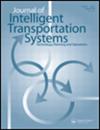Fuzing multiple erroneous sensors to estimate travel time
IF 2.8
3区 工程技术
Q3 TRANSPORTATION
Journal of Intelligent Transportation Systems
Pub Date : 2025-09-03
DOI:10.1080/15472450.2024.2315514
引用次数: 0
Abstract
Estimating accurate travel time information is one of the fundamental tasks in controlling city traffic. In general, fuzing multiple sensors can generate more accurate information to measure traffic flow characteristics than using each one separately. However, in addition to the cost of installing a new sensor system, the costly steps of data cleaning and preparation are required before using a new sensor; therefore, it is essential to estimate the marginal benefit of adding a new sensor vs its marginal cost. Three datasets are generated and analyzed in this study, namely a Hypothetical Ground Truth (HGT), an Erroneous Ground Truth (EGT), and a set of Erroneous Sensors (E-Sensors). This study also challenges the assumption of an error-free Ground Truth (GT). By computing the optimal number of detections to approximate the GT, the effect of (endogenous) error in the fusion procedure is evaluated. Furthermore, by fuzing the E-Sensors that had different levels of (exogenous) error, it is revealed that the error level has a limited effect on the result of fusion. Multiple sets of E-Sensors are assessed and the RMSE values between using Erroneous Ground Truth and Hypothetical Ground Truth are measured, which shows a significant difference. Additionally, the effect of increasing the number of sensors in estimating the travel time is investigated, which shows that adding a new sensor can improve fusion accuracy if the accuracy of the added sensor is better than a given threshold. Moreover, the optimal number of detections to approximate the ground truth is studied. Real traffic data is also used to validate the results.
引信多个错误传感器来估算旅行时间
估算准确的旅行时间信息是控制城市交通的基本任务之一。一般来说,使用多个传感器可以产生更准确的信息来测量交通流量。
本文章由计算机程序翻译,如有差异,请以英文原文为准。
求助全文
约1分钟内获得全文
求助全文
来源期刊
CiteScore
8.80
自引率
19.40%
发文量
51
审稿时长
15 months
期刊介绍:
The Journal of Intelligent Transportation Systems is devoted to scholarly research on the development, planning, management, operation and evaluation of intelligent transportation systems. Intelligent transportation systems are innovative solutions that address contemporary transportation problems. They are characterized by information, dynamic feedback and automation that allow people and goods to move efficiently. They encompass the full scope of information technologies used in transportation, including control, computation and communication, as well as the algorithms, databases, models and human interfaces. The emergence of these technologies as a new pathway for transportation is relatively new.
The Journal of Intelligent Transportation Systems is especially interested in research that leads to improved planning and operation of the transportation system through the application of new technologies. The journal is particularly interested in research that adds to the scientific understanding of the impacts that intelligent transportation systems can have on accessibility, congestion, pollution, safety, security, noise, and energy and resource consumption.
The journal is inter-disciplinary, and accepts work from fields of engineering, economics, planning, policy, business and management, as well as any other disciplines that contribute to the scientific understanding of intelligent transportation systems. The journal is also multi-modal, and accepts work on intelligent transportation for all forms of ground, air and water transportation. Example topics include the role of information systems in transportation, traffic flow and control, vehicle control, routing and scheduling, traveler response to dynamic information, planning for ITS innovations, evaluations of ITS field operational tests, ITS deployment experiences, automated highway systems, vehicle control systems, diffusion of ITS, and tools/software for analysis of ITS.

 求助内容:
求助内容: 应助结果提醒方式:
应助结果提醒方式:


